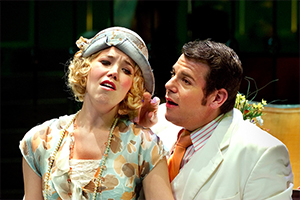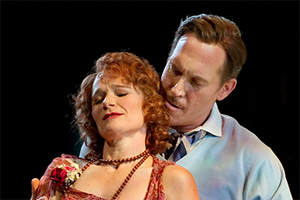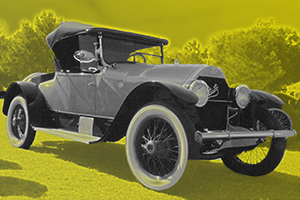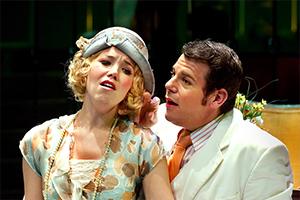
photo by Steve Bartolomeo
Was Jay Gatsby speaking about his own opera here at the Yerba Buena Center of the Arts when he sings in Act 2, “My heart was in a constant turbulent riot — colors, scents, possibilities without end, but missing something”? In an otherwise wonderful production by Ensemble Paralléle, John Harbison’s The Great Gatsby, newly trimmed and reorchestrated with the help of Jacques Desjardins, the central character’s mystery, longings and tragedy fail to rise above uninvolving, overcomplicated music, and stiff acting and/or direction. But much of the rest is a triumph of improvement over previous productions, and a credit to Paralléle’s Artistic Director and Conductor Nicole Paiement and her team, who have whipped the trappings into outstanding shape around a score whose secondary elements far outshine its core raison d’être.
Many aspects of the production reach a level close to perfection. Complaints in earlier productions in Chicago and New York about the cavernous sets no longer apply in the medium-sized Novellus Theater. Matthew Antaky’s set designs are simple, attractive, and maintain focus where it belongs, be it crowd scenes or intimate living-room discussions. Austin Forbord’s videography is some of the best I’ve seen anywhere for an opera. His projections from the driver’s point of view in Gatsby’s yellow roadster were highly effective, and his use of the “T. J. Eckleburg, Oculist” billboard became a coup de theatre when its glasses suddenly lowered down and surrounded Gatsby and paramour Daisy on the stage. Christine Crooks’ costumes were varied and appropriate, and Tom Segal’s dance choreography worked well in the available space.

photo by Steve Bartolomeo)
Most of the performances, too, were top notch. The two standouts for the evening were soprano Susannah Biller as Daisy and tenor Daniel Snyder as her overbearing husband Tom. Biller’s voice was light, sweet, and gorgeous; the variety of expression perfectly matched the flightiness of her character. Snyder’s voice was powerful, rich enough to be a baritone’s, and well suited to the role. The Valley of Ashes marital disaster was brilliantly sung by mezzo-soprano Erin Neff as Myrtle and the Caliban-like Bojan Knezevic as George. Their scenes were the few that provided opportunities for passion at a true operatic intensity, and they played them to the hilt. The pair of observers to the action, baritone Jonas Detwiler as Nick and mezzo Julienne Walker as Jordon, contributed fine singing. Minor roles were flawlessly executed by the chorus and Carrie Zhang, Roger McCracken, John Minagro, Roy Eikleberry, and most notably, Mark Robinson as a band crooner. Brian Staufenbiel’s direction for almost all singers was effective.
But tenor Marco Panuccio in the title role was less convincing. This had nothing to do with his voice, which was exquisite. Instead, a number of factors combined to negate his vocal contribution. Gatsby is supposed to be a man of mystery, at first looked at from afar by the other characters and partygoers. Nothing Panuccio did was able to provide this effect, nor did he look the part. Staring off into space like a statue of George Washington certainly didn’t do the trick. Later, when Gatsby’s vulnerabilities come to the fore, neither Panucio’s voice, gestures nor expressions were able to convey his longings or the existence of a cracking facade. Worst of all, composer Harbison’s music failed as well to immediately convey any of these characteristics.

I heard a previous version of the opera in Chicago. I attended a preview and heard a rehearsal of excerpts here in San Francisco. I have always been impressed with the technical qualities of Harbison’s music and his sincerity of purpose. There is no question that he can write a tune: Several occur in Gatsby, brilliant pastiches composed by Harbison in 20’s style. One of these, which I whistled on the way out, later morphed in my head to a phrase from Gershwin’s American in Paris. But no memorable tune is bestowed on the major characters, despite the many solos, duets etc. available in the composers excellent libretto adapted from the novel.
There’s nothing wrong with dissonance, per se, but unrelieved dissonance is only appropriate for two characters in this opera, Myrtle and George. Besides the numerous 20’s-era-like songs in the background, which are usually drowned out by an obsessive polyphonicism from the singers, there are few immediately audible tonal triads until the offstage chorus in the concluding funeral scene.
There is fine music in Gatsby, especially in the industrial orchestral interludes expressing the blossoming of Age of the Auto (where people died in car crashes at a rate 14 times that of today), and underclass victims of industrialization in the Valley of Ashes. Later, as the tension rises when Tom faces Daisy’s infidelity, the high degree of dissonance is called for. But earlier in the opera, when easygoing, devil-may-care attitudes and cultural shallowness go hand in hand, more tonality should be embraced, perhaps laced with some irony or other humor. The eclectic and heavily borrowed style of the American 1920s composer and enfant terrible George Antheil would seem more appropriate in Act 1.
Considering all this opera has been through, and the tremendous work all concerned have lavished on this production, I’d say Gatsby’s yellow roadster is more than ready for the highway—i.e., additional venues made possible by Desjardins’ reduction and Harbison’s wise decision to cut tens of minutes from its original length. Perhaps if the right Gatsby is found, and Harbison’s less-than-accessible core of music becomes more familiar through repeated listenings on recordings, or he adds an inspired aria to a principal character, the roadster will truly be seen in standout yellow, and admired by all.

